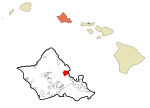Kahaluʻu, Hawaii
Census-designated places in Honolulu County, HawaiiPages with Hawaiian IPAPopulated coastal places in HawaiiPopulated places on Oahu

Kahaluʻu (; Hawaiian pronunciation: [ˈkɐhɐˈluʔu]) is a residential community and census-designated place (CDP) in the City and County of Honolulu, Hawaii, United States, in the District of Koolaupoko on the island of Oahu. In Hawaiian ka haluʻu means "diving place". As of the 2020 census, the CDP had a total population of 5,241.
Excerpt from the Wikipedia article Kahaluʻu, Hawaii (License: CC BY-SA 3.0, Authors, Images).Kahaluʻu, Hawaii
Kamehameha Highway,
Geographical coordinates (GPS) Address Nearby Places Show on map
Geographical coordinates (GPS)
| Latitude | Longitude |
|---|---|
| N 21.461111111111 ° | E -157.84111111111 ° |
Address
Kamehameha Highway (State Highway 83)
Kamehameha Highway
Hawaii, United States
Open on Google Maps










